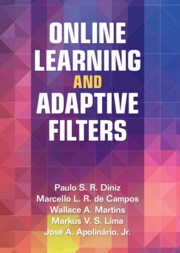3 - Kernel-Based Adaptive Filtering
Published online by Cambridge University Press: 24 November 2022
Summary
This chapter explains the basic concepts of kernel-based methods, a widely used tool in machine learning. The idea is to present online parameter estimation of nonlinear models using kernel-based tools. The chapters aim is to introduce the kernel version of classical algorithms such as least mean square (LMS), recursive least squares (RLS), affine projection (AP), and set membership affine projection (SM-AP). In particular, we will discuss how to keep the dictionary of the kernel finite through a series of model reduction strategies. This way, all discussed kernel algorithms are tailored for online implementation.
Information
- Type
- Chapter
- Information
- Online Learning and Adaptive Filters , pp. 60 - 108Publisher: Cambridge University PressPrint publication year: 2022
